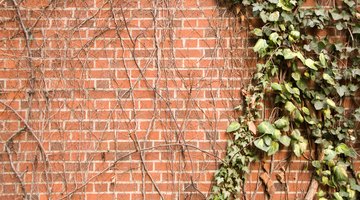How to Remove Oxidized Ivy Suckers on Brick
While ivy-covered brick can be aesthetically pleasing, the little suckers that attach to the wall, particularly with Boston ivy, can be a nuisance. If you decide to remove the ivy, simply pulling the ivy suckers from the brick can damage the structure.

Things You Will Need
- Safety goggles
- Gloves
- Dust mask
- Wire brush
- Drill with a brush attachment
- Heavy duty paint stripper
- Pressure washer or neutralizing agent
If the ivy dies from natural causes, the vines dry out and the suckers rot. These rotten suckers then oxidize and stain your brick. Once the suckers have oxidized, removal is a difficult, time-consuming project.
-
Don your protective apparel: safety goggles, gloves and a dust mask.
-
Scrub the oxidized ivy suckers with a wire brush. This will take care of the most easily removed particles.
-
Attach a brush attachment to a drill and lock it in place. Scrub the ivy suckers with this brush attachment.
-
Apply a heavy-duty paint stripper formulated for brick. Application instructions vary depending on the brand, so follow your product’s instructions. Leave the stripper on the affected brick for up to 24 hours. Remove the stripper with a pressure washer or neutralizing agent, depending on your product.
Tip
Ivy suckers are easier to remove before they oxidize. When removing ivy, the Brick Industry Association recommends that you cut the ivy away from the wall, getting as close to the wall as possible. Wait until the suckers dry -- approximately two or three weeks -- and then scrub them with a stiff brush and a mild laundry detergent.
References
Tips
- Ivy suckers are easier to remove before they oxidize. When removing ivy, the Brick Industry Association recommends that you cut the ivy away from the wall, getting as close to the wall as possible. Wait until the suckers dry -- approximately two or three weeks -- and then scrub them with a stiff brush and a mild laundry detergent.
Writer Bio
Kat Black is a professional writer currently completing her doctorate in musicology/ She has won several prestigious awards for her research, and has had extensive training in classical music and dance.
Photo Credits
- Jupiterimages/Photos.com/Getty Images
- Jupiterimages/Photos.com/Getty Images
More Articles



